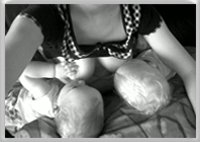Latching On Challenge
Achieving correct latching on from the first days of breastfeeding makes entire nursing experience more pleasant. It alleviates the risk of developing sore nipples, breast infections, and clogged milk ducts.
Biological Nurturing*
Biological Nurturing is all about letting the baby follow instincts and reflexes and lead the feeding process.
In my opinion, it is the most natural and holistic way of breastfeeding. There are no set instructions and rigid rules. Many mom-baby couples prove to be very successful in it.
If you decide to give it a try, here is how:
- After delivery ask to place your baby on your tummy, provided there are no incisions from a C-section.
- Let your baby find your nipple on its own.
- Re-adjust your baby’s position as needed. When finding the breast your baby may latch on its own and start breastfeeding.
- It maximizes skin-to-skin contact, touching, caressing and your baby's involvement in the process.
- It
lets your baby find the most comfortable position for enjoying the meal
and freely use his/her hands to discover the breast.
If this approach doesn't work, try more traditional ways of getting your baby to latch (see below). Whatever works, the key is to breastfeed as soon
after the delivery as possible.
What is a Correct Latch?

To attract your baby to the breast you only need to slightly touch its lips with your nipple. Leave the rest to the rooting reflex (a reflex prompting a baby to open the mouth when lips or cheeks are touched).
Your baby will open the mouth wide in search of a nipple.
The latch should be on the nipple and the areola. Depending on the areola size your baby may be able to grasp all of it or just some, but at least an inch of areola should be covered with the lower jaw.
It is important that your baby grasps more of the areola under the nipple than above it, because most of the sucking is done with the lower jaw.
To achieve correct latching on, place your finger on the areola above your nipple and press a little. This will push your nipple up and make your baby slightly raise his/her head.
From there wait when your baby opens mouth wide, then bring its body closer with your supporting arm and direct the breast into the mouth.
The finger you placed above the nipple may end up in your baby’s mouth. Slowly remove it.
Remember: Do not bring your breast to your baby's mouth. Instead, bring your baby to the breast.
Let your hand go. Do all these steps quickly. This technique ensures your baby gets more of the areola tissue beneath the nipple.
Some breastfeeding nipples and areolas become larger and harder to grasp. While tilting you nipple up, also compress your areola slightly to make it narrower and easier to get into your baby’s mouth.

Some babies press their lips tight together or even roll them in. After you encouraged your baby to open mouth wide, gently press on his/her chin to help relax the lips (Baby in the picture latched on correctly).
You may need to support your breast to help your baby latch. After the baby latches on, let go off the breast.
Your baby’s chin should be snuggled into your breast. The nose should only slightly be touching your breast. Bring your baby’s bottom closer to you to achieve correct angle.
Breastfeeding should NOT hurt. If it does, re-latch your baby.
Make sure you both are positioned correctly. Read about correct positioning here.
Important: Look at this picture of an INCORRECT shallow latch.

If your baby latches on to your nipple and not the areola:
- break suction by carefully sticking your pinky into the corner of your baby’s mouth and slightly pulling away from the nipple
- re-latch
- make sure your baby gets a mouthful of breast
Latching Problems
^ Your baby may experience difficulty latching on if your breasts are engorged. Fuller breasts have flatter nipples. Express some milk to relieve fullness. Visit Engorgement section to read more.
^ Birth medications and delivery stress can wear your baby out. Don’t be pushy when offering the breast. If your baby doesn’t latch on, try again later. Some babies take days to start breastfeeding.
^ If your baby doesn’t latch on for longer than 24 hours, hand express some milk and use feeding techniques to supplement. Read about these techniques here.
^ If your mature milk came in but your baby doesn’t latch on, start pumping or hand expressing to maintain milk supply. Talk to a lactation consultant.
^ Acknowledge that these problems are temporary and keep trying. All babies naturally want to breastfeed, but many need your help learning how to.
^ Your baby may not be able to latch on effectively if he/she is tongue-tied (like my son was). It is important to spot and correct this problem as soon as possible. My son was a couple of days old when we got it fixed. He breastfed like nothing happened an hour after the procedure!
^ If your milk supply is still low, but your baby wants to nurse more, try breast compressions to increase milk flow. Visit Low Milk Supply section to read more.
^ Your baby may have trouble latching on if you have irregularly shaped nipples. Visit Flat/Inverted Nipples section to read more.
^ Avoid using bottles or pacifiers at least until breastfeeding stabilizes to avoid nipple confusion.
^ Latching on can be especially challenging for premature babies. You may need to help your baby latch on and stay on the breast. Firmly support your baby while breastfeeding. Ask hospital lactation specialist for help.
Am I Getting It Right?
- If the latch-on is correct your baby should be sucking rhythmically and swallowing every suck or two.
- With correct latch-on your nipple should not be pressed on the sides, pinched, sore or cracked.
- With correct latch-on the baby should get full and look happy and satisfied after the
feeding. Your breasts should feel empty.
* Biological Nurturing is described by Doctor Suzanne Colson
Home › Positions Basics › Latching On
Home › Breastfeeding Problems › Latching On













